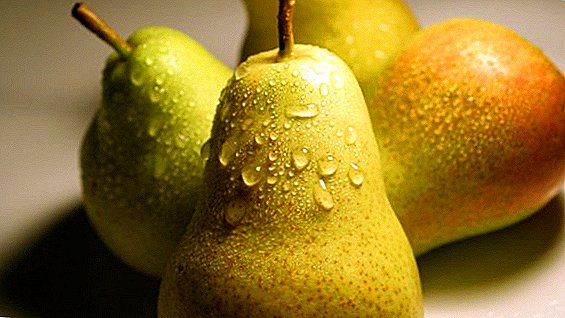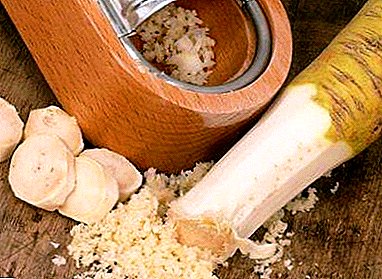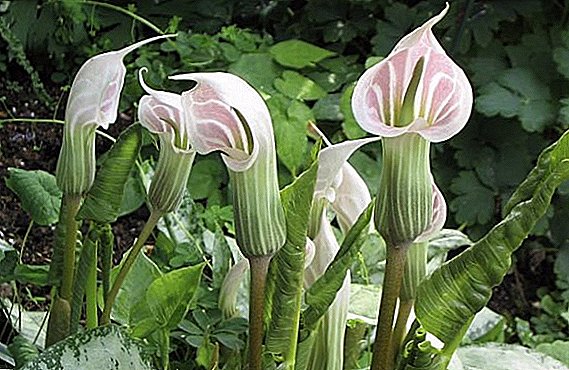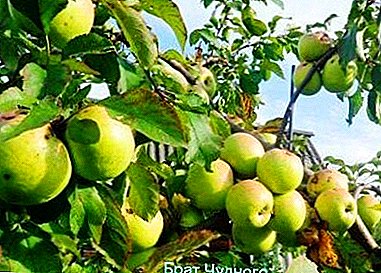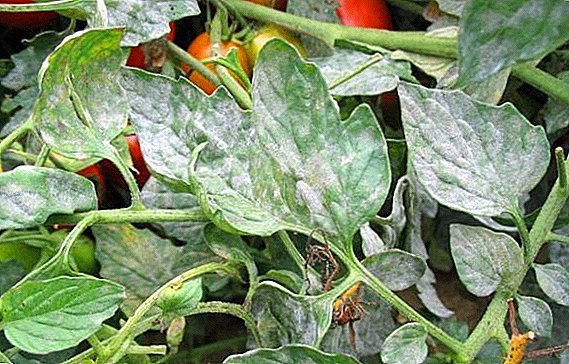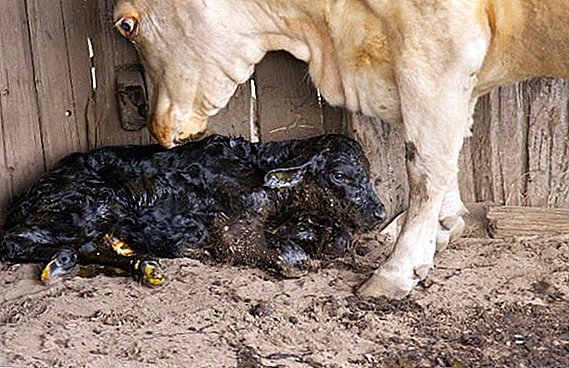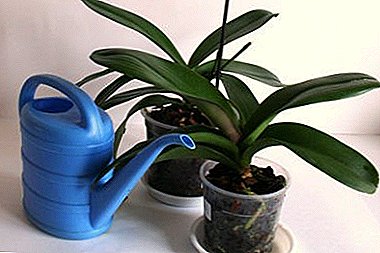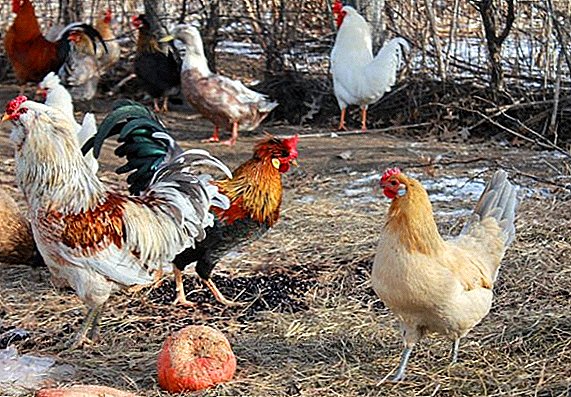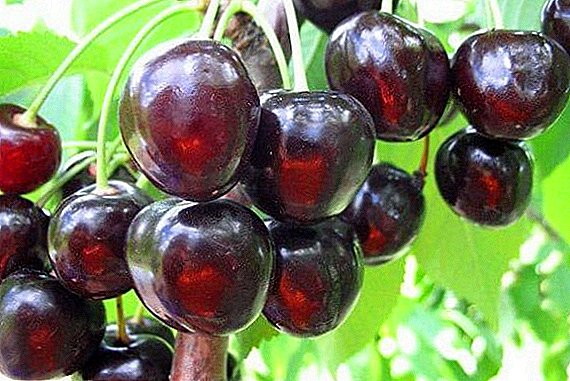 Rarely there are people who do not like sweet cherries. This is one of the most popular berries, which has been cultivated in Europe and Asia for a couple of millennia.
Rarely there are people who do not like sweet cherries. This is one of the most popular berries, which has been cultivated in Europe and Asia for a couple of millennia.
There are several thousands of cherry varieties. Consider in more detail the grade "Napoleon black."
About breeding
Sweet cherry belongs to ancient fruit crops. Homeland is Asia. But the berry came to Europe for a long time, even before the beginning of our era. On the territory of Ukraine and Russia, cherries are grown since the times of Kievan Rus.  German gardeners engaged in the selection of sweet cherries from the XVIII century. Black Napoleon is one of the oldest varieties that were bred in Western Europe as early as the 19th century. In the countries of the former Soviet Union, it has been cultivated since the 1930s. Since then, many new varieties and hybrids. But "Black Napoleon" does not give up their positions, as it has remarkable characteristics.
German gardeners engaged in the selection of sweet cherries from the XVIII century. Black Napoleon is one of the oldest varieties that were bred in Western Europe as early as the 19th century. In the countries of the former Soviet Union, it has been cultivated since the 1930s. Since then, many new varieties and hybrids. But "Black Napoleon" does not give up their positions, as it has remarkable characteristics.
Did you know? For the first time, Teofrast, an ancient Greek scholar of the 4th century BC, mentions cherries in his work. And in the I century AD Roman historian Pliny already writes about ten varieties of sweet cherry, then known in Rome.
Description and characteristics
Cherry trees not only generously give the owners delicious berries, but can decorate any garden. They look very beautiful during flowering and fruiting.
Wood
The "Napoleonic" tree grows large (5-6 m). It grows especially intensively before it begins to bear fruit. Cherry bark differs from cherry color: it is much lighter. Rare branches covered with dense foliage form a beautiful spherical crown. The leaves are large, elongated, with a sharp tip, dark green in color. White flowers bloom on the bouquet branches, gathered in inflorescences of 2-3 things. 
Fruits
"Black Napoleon" is one of Bigarro varietiesThe fruits of which are distinguished by dense pulp, which does not soften in compotes and preservation, and are stored for a long time. Like other bigarros, black Napoleon's cherries are firm, dense and crunchy. They are quite large, weighing 6-7 g.
The skin is also thick and thick, does not burst. Inside the bone is hidden in the form of a pointed egg, the size is average, and the weight is about 6.5% of the total weight of the berry. The shape of the berries is not round, but more heart-shaped. The color of the skin, like the pulp, is dark ruby, sometimes appears black. The berries are very tasty, richly sweet, sour and even slightly bitter.
Read also about the varieties of dark cherries: "Farewell", "Favorite Astakhova", "Adeline", "Ovstuzhenka".
Some features of the variety
To grow black cherries "Napoleon" should be the same as other varieties. But its distinctive features still affect the care and harvest.
Winter hardiness and disease resistance
Sweet cherries themselves are thermophilic. Black Napoleon is no exception. Average frost resistance. It easily survives in the conditions of the Ukrainian winter with frosts down to -30 ° С. Therefore, there are no territorial restrictions in Ukraine.  And in Russia it can survive only in the southern regions.
And in Russia it can survive only in the southern regions.
"Napoleon" is resistant to many diseases. But without chemical treatment, it can still get sick with moniliasis, coccomycosis and fruit rot. There is a threat from such pests: cherry fly, aphid, leaf-eating fly, cherry elephant.
Protection against diseases and insects is the prophylactic use of fungicides and insecticides at different stages of tree development: during bud break, flower break, at the end of flowering, during the fruit growth period and after harvest.
Pollinators
"Black Napoleon" refers to samobesplodnymi varieties of sweet cherries. This means that there will be no fruit on the tree or will be tied, but few, without cross-pollination. For maximum yield you need to plant it together with the pollinator, that is, the cherry of another variety, which blooms simultaneously with "Napoleon". There is no need to plant a pollinator if a tree that is already suitable for this role is already growing on a neighboring plot. Best pollinators for black cherry "Napoleon black" are: "Valeriy Chkalov", "Cassini early", "Jabule", "Drogan yellow", "Early mark". 
Ripening period and yield
The young tree begins to bear fruit on fourth year after landing. Although "Napoleon" blooms early (end of March - early April), but the berries ripen only in summer (first to second decade of June). Therefore, it refers to late cherry varieties). This is very convenient, since Napoleon's cherries ripen at a time when other varieties have already moved. Napoleon has a high yield: one tree can produce 20-50 kg of fruit per season.
Did you know? Cherries in ancient Rome were called bird cherries. Perhaps because it is loved not only by people, but also by birds. And perhaps because, according to the legend, cherries appeared in Europe precisely because of the birds that brought the cherry stones there.
Transportability
Good transportability refers to the benefits of the "Napoleon Black" variety. Thanks to the dense pulp and thick skin, berries can be transported over long distances. However, they do not lose their presentation, retain their shape and taste.
Another virtue of the variety is good keeping quality of fruits. In a cool place (cellar or refrigerator), the cherries can be stored for two weeks. At a suitable temperature, they remain fresh for a long time and do not deteriorate. 
Direction
Black cherries "Napoleon" are very tasty fresh. Tasters highly appreciated their taste (4.9 points out of 5). Berries are consumed not only fresh.
We advise you to read about the beneficial properties of cherries and the preparation of berries for the winter: white cherry jam, jam with pits.
They are used in different directions:
- In cooking. Dense berries do not soften during heat treatment. Therefore, they are prepared compotes, jams, jellies, candied fruits and canned. They are dried and frozen.
- In nutrition. Low-calorie cherry berries (50 kcal per 100 g). They are included in a diet for weight loss.
- In folk medicine berries are used (fresh and dried), stalks, leaves and flowers. They have a lot of useful properties: they strengthen, anesthetize, tone up, improve blood circulation, appetite and peristalsis of the intestines, cleanse the body of harmful cholesterol. From them prepare infusions and decoctions.
- In cosmetology. Due to the high content of antioxidants, sweet cherry is able to slow down skin aging. They make masks, creams and other cosmetics from it.

Choosing a place
If you choose the right place for the cherries and provide good care for them, then she will thank for the abundant harvest up to one hundred years. The selected location must meet the following requirements:
- a lot of sun and without a shadow (knowingly the sweet cherry was given the name "sun berry");
- a well-ventilated place, but closed from strong winds, for example, near the southern wall of the house;
- the soil should be light and fertile, for example, calcareous, regularly fertilized with humus;
- there should be no stagnation of moisture, the proximity of groundwater is not desirable (at least two meters).
Sprouting a cherry tree from a stone is a fascinating activity that can be done with children at home.
Landing rules
Cherries sown in spring and autumn. The earth at this time is wet and fairly soft, so the seedling is easy to take root. Each season has its advantages and disadvantages.
- Warm autumn best suited for planting. Before the onset of winter, the root has time to go deep and grow. And with the onset of spring, the plant begins to grow and develop intensively. But in the conditions of early winter with frost, a tree can freeze.
- Landing early in the spring free from the risk of freezing. But you need to have time to do it before the swelling of the kidneys. The tree, planted later, will hurt and may not settle down.
 Place for wood is important to prepare in advance. If planting is planned in the spring, then the soil can be prepared in the fall. For autumn planting, preparatory work should be carried out at least two weeks. They include: cleaning weeds and debris, applying organic fertilizer (2 buckets of humus per hole) and digging up the place of the future pit.
Place for wood is important to prepare in advance. If planting is planned in the spring, then the soil can be prepared in the fall. For autumn planting, preparatory work should be carried out at least two weeks. They include: cleaning weeds and debris, applying organic fertilizer (2 buckets of humus per hole) and digging up the place of the future pit.
Planting is as follows:
- At a prearranged place, a pit is dug out, 70-80 cm deep and about 1 m in diameter. There should be enough space for the root.
- If the seedling was previously in a temporary container, then it should be carefully removed and placed together with an earthy clod in a hole. If the roots are bare, then at the bottom of the pit you need to make a mound of fertile soil, which you need to distribute the roots.
- No need to plant a tree very deep. Its basal neck should peek out from the ground by about 5 cm.
- The pit is filled with fertilized soil and well compacted. You can make an earthen rim on the edge of the buried pit to collect rainwater.
- You need to pour plenty of water.
Cherry trees grow big. Therefore, when planting several seedlings, the distance between the pits should be at least 3-4 m.
Video: planting sweet cherry
How to care
Even if the cherry has been planted on time, and in good soil, it needs further attention. It needs to be watered, fed and shaped regularly.
Watering
Watering the plant is very important, but this should be done carefully to prevent overmoistening. The frequency of watering depends on the phase of tree development and weather conditions.
It is necessary to water a sweet cherry:
- in May, after flowering: moisture is needed for the development of the fruit;
- in the first half of June, when the fruits are poured: this will help the berries to be juicy and beautiful;
- in dry time: it is necessary to fill in plentifully, well saturating the earth;
- in the autumn, before the cold: moisture is needed to safely winter.
 Watering is necessary every two to three weeks, and during the drought more often (every week).
Watering is necessary every two to three weeks, and during the drought more often (every week).
Important! It is not necessary to water the cherry during flowering, otherwise the ovary will crumble, and during the ripening period of the berries, so that they do not crack..
Top dressing
For the harmonious development of the tree and maximum fruiting, it is necessary to regularly feed the plant with both organic and mineral fertilizers. Feed mode looks like this:
- organic matter (humus or rotted chicken manure) is introduced during the digging of the soil around the tree every 2-3 years;
- humus or compost can be mulched pristvolny circle: during watering the roots with water and receive nutrient fertilizer;
- mineral fertilizers with a nitrogen content (ammonium nitrate, ammonium sulphate) are applied as a liquid in spring (May) and summer (June);
- phosphate and potash fertilizers (buckwheat ash, superphosphate, potash salt) feed the tree in autumn (September): they will give strength for a successful overwintering and help the spring in the formation of buds.
Important! It is impossible to feed with fresh organic fertilizer (manure): it can harm, burning the root, and will not be useful, as it will decompose in the ground for a long time.
Caring for a circle
Do not underestimate the importance of caring for pristvolnom circle.  It is necessary for the health of the whole tree.
It is necessary for the health of the whole tree.
- Every time after watering you need to loosen the ground to open access to the roots, air and moisture.
- Weed grass must be destroyed as it "steals" nutrients and interferes with the normal development of a young tree.
- Mulching the ground around the trunk allows you to retain moisture and does not allow the weeds to grow. Some growers use mulch as mulch. compost. Others plant the siderats around the tree for the same purpose.
Learn how to make compost with your own hands: in garbage bags, in a compost pit.
Cropping and crown formation
Cherry trees grow intensively, especially in the early years. Therefore, they need to be cut off every year. This should be done in early spring, before the buds swell, or in the fall.
Trimming is carried out in three directions:
- The shortening of young annual branches by one-fifth: held in the years of growth before the tree begins to bear fruit.
- Removal of incorrectly growing branches (inside the crown). Due to this, a well-lit crown is formed, for each branch that is easy to reach.
- Sanitary pruning of dried, frozen and broken branches.
Read also about the basics of seasonal pruning of trees, as well as the secrets of anti-aging pruning.
After the procedure, it is necessary to treat the sections with putty: garden pitch, paint or varnish. This will help in fast healing and will help prevent diseases. 
Protection against cold and rodents
Sweet cherry "Napoleon" quite cold-resistant. But if weather forecasters predict a snowless winter with severe frosts, then it is better to err. By taking the necessary measures, you can protect the tree from freezing and large rodents.
These measures include:
- lime whitewash, which protects the trunk from hypothermia during sudden changes in temperature in winter, as well as from insect larvae remaining in the bark;
- the wrapping of the trunk with different insulators (with roofing felt, rags, coniferous branches) will serve as protection against frost and against rodents;
- mulching with branches and shelter with a snowdrift will warm the root system;
- insulation of the crown of young seedlings: branches, pressed against the trunk, are not tied up and covered with sacking.

Advantages and disadvantages
Virtues varieties "Napoleon" black:
- high yield;
- excellent taste;
- berries of universal application;
- good transportability and keeping quality of fruits;
- rarely gets sick;
- good level of frost resistance.
Disadvantages Little:
- demanding of the place and soil;
- the need for pollinators.
 As you can see, this cherry has more advantages than disadvantages. And although black “Napoleon” is already old, it is not inferior to new varieties, and even surpasses some.
As you can see, this cherry has more advantages than disadvantages. And although black “Napoleon” is already old, it is not inferior to new varieties, and even surpasses some.


